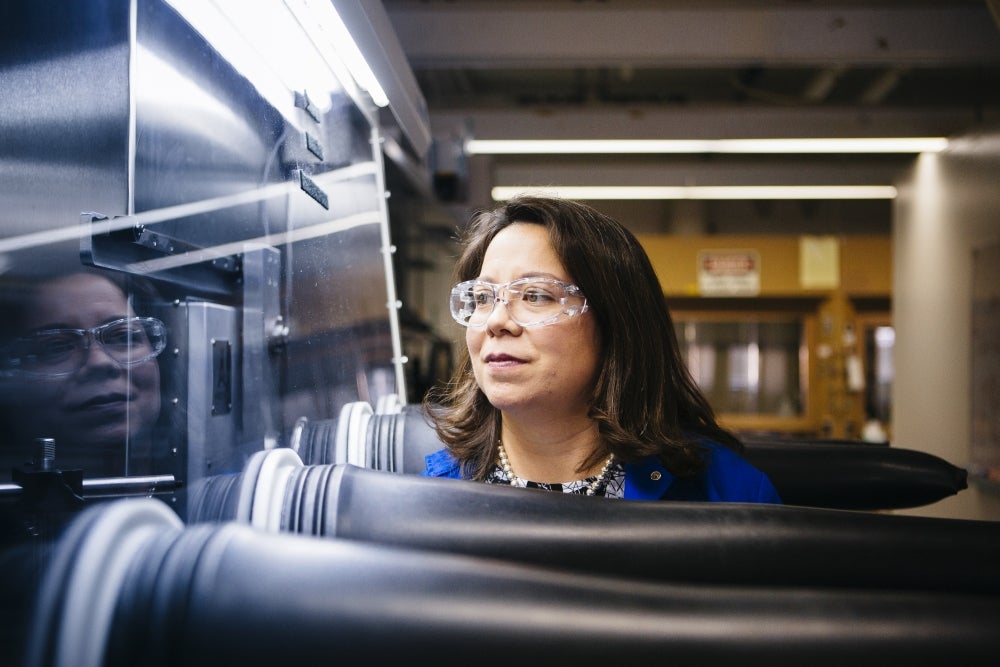
A Call to Remember
When her phone rang and the caller identification read “DOE,” Rachel Segalman’s interest was instantly piqued. So were her nerves. The Edward Noble Kramer Professor and chair of UC Santa Barbara’s Chemical Engineering Department had been waiting to hear back about a proposal for the Department of Energy.
“I answered the call with trepidation,” Segalman said. When the person on the other end said, “Professor Segalman?” she answered “Yes,” but was a bit hesitant, she said, because her program mangers typically are not as formal.
The caller introduced herself: “This is Secretary Granholm.” That would be Jennifer Granholm, the Secretary of Energy and head of the DOE.
“I was a little speechless,” recalled Segalman. “What does one say in response to a phone call from a Cabinet secretary?”
It wasn’t about her proposal. Granholm was calling to tell Segalman that she was the recipient of the 2021 Ernest Orlando Lawrence Award in Condensed Matter and Materials Science, the DOE’s highest scientific honor. The Lawrence Award honors mid-career U.S. scientists and engineers for their exceptional contributions and achievements in research and development supporting the broad missions of DOE and its programs. Segalman was cited for “significant fundamental materials science and engineering contributions to self-assembly and structure-property relationships in functional polymer systems, with specific applications to photovoltaic, thermoelectric and membrane technologies.”
“All I could think about during the call was how this was the award that many of the all-around scientists and leaders that I looked up to as a young scientist had won,” said Segalman, referring to Paul Alivisatos (2006), Alex Pines (1988), Arup Chakraborty (2006) and Carolyn Bertozzi (2014). “The attribute that threads together all of the prior recipients is that they are great scientists who identified and made a significant impact on basic, fundamental scientific problems of critical energy consequence. They are also generous, insightful mentors and educators. As a result for me, receiving this honor comes with a huge sense of accomplishment and responsibility.”
With particular interests in energy, efficiency, sustainability and materials and interfaces, Segalman’s research is focused on controlling the self-assembly, structure and properties in functional polymers. Structural control over soft matter through microscopic length scales is an essential tool for optimizing properties in applications ranging from solar and thermal energy to biomaterials. Her work paves the way for the development of sophisticated materials for such energy application as photovoltaics, fuel cells and thermoelectrics
“Rachel Segalman has been at the forefront in the materials and chemical engineering, making major contributions to our general knowledge of block polymers and hybrid thermoelectric materials,” said Tresa Pollock, interim dean of engineering and ALCOA Distinguished Professor of Materials. “We are extremely proud that the Department of Energy has recognized the impact and significance of Professor Segalman’s research, and we are thrilled to extend to her our deepest congratulations.”
The Lawrence Award was established in 1959 to honor the memory of the late Ernest Orlando Lawrence, who won the 1939 Nobel Prize in Physics for inventing the cyclotron, a particle accelerator, and after whom two DOE national laboratories, one in Berkeley and the other in Livermore, are named. Segalman has strong ties to both labs. She started her career with a joint appointment as an assistant professor of chemical engineering at UC Berkeley and as a faculty scientist at the Lawrence Berkeley National Laboratory (LBL) Materials Science Division. As she moved through the ranks at Berkeley, she was deeply engaged both on campus and at the labs.
“My last year at the LBL, I was the director of the Materials Science Division, and I had a picture of Lawrence in my office,” recalled Segalman, an elected member of the National Academy of Engineering and a fellow of the American Academy of Arts and Sciences and the American Physical Society. “He was absolutely steeped into the fabric of the lab.”
In addition to Segalman’s selection in condensed matter and materials sciences, the DOE selected nine scientists and engineers in eight other categories: atomic, molecular, and chemical sciences; biological and environmental sciences; computer, information, and knowledge sciences; energy science and innovation; fusion and plasma sciences; high-energy physics; national security and nonproliferation; and nuclear physics.
“I am thrilled to recognize these researchers and significant advances they have contributed to society,” said Asmeret Asefaw Berhe, director of the DOE Office of Science. “Scientists like these individuals are the backbone of DOE, and we cannot achieve our mission without them. I’m excited to see what the future holds for them and where they may lead us.”
Lawrence Award winners receive a citation signed by the Secretary of Energy, a gold-plated medal bearing the likeness of Ernest O. Lawrence, and an honorarium. The 10 recipients will be honored September 22 during a hybrid award ceremony in Washington, D.C.



